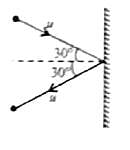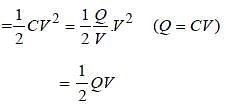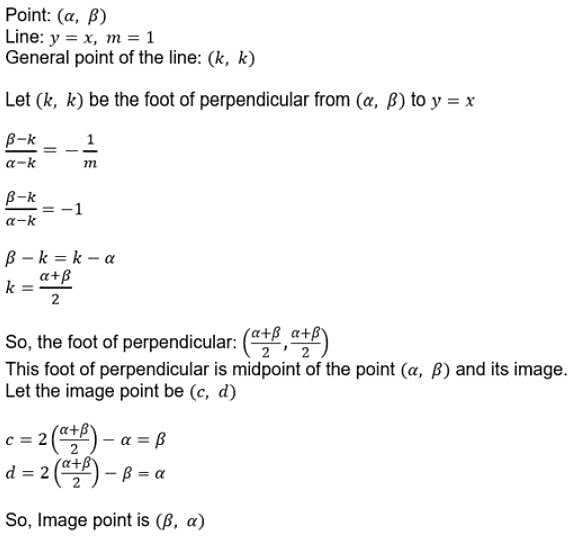Indian Air Force Agniveer Science Subject Mock Test - 5 - Indian Air Force Agniveer Vayu MCQ
30 Questions MCQ Test Indian Air Force Agniveer Vayu Group X Mock Test Series 2025 - Indian Air Force Agniveer Science Subject Mock Test - 5
A particle starts its motion from rest under the action of a constant force. If the distance covered in first 10 seconds is S1 and that covered in the first 20 seconds is S2, then: [2009]
A ball of mass m strikes a rigid wall with speed u at an angle of 30o and get reflected with the same speed and at the same angle as shown in the figure. If the ball is in contact with the wall for time t, then the force acting on the wall is


A body of mass 1 kg is thrown upwards with a velocity 20 m/s. It momentarily comes to rest after attaining a height of 18 m. How much energy is lost due to air friction? (g = 10 m/s2)
Direction of linear velocity of a particle rotating in a circular motion is :
In an open system, for maximum work, the process must be entirely
Which of the following statement is true for a thermodynamical system where ∆U is the increase in internal energy and ∆W work done respectively?
In a simple pendulum the restoring force is due to
Energy stored in a capacitor is
Resistance of a conductor is
According to Farady's law
According to Maxwell’s equations
Arrange the materials in ascending order of energy band gaps:
Which of the following is not a semiconductor?
Given n(U) = 20, n(A) = 12, n(B) = 9, n(A ∩ B) = 4, where U is the universal set, A and B are subsets of U, then n((A ∪ B)c) =
What is the value of cos 1050 + cos750 ?
The image of the point (α,β) is the line x = y is
The equation of circle whose centre is (2, 1) and which passes through the point (3, – 5) is:
The eccentricity of the ellipse 9x2 + 5y2 – 30y = 0 is:
Differential equation of the family of parabolas having vertex at origin and axis along positive y-axis is
Read the each sentence to find out whether there is any grammatical error in it. The error, if any will be in one part of the sentence. The letter of that part is the answer. If there is no error, the answer is 'D'. (Ignore the errors of punctuation, if any).
If sentence (3), 'In most economic systems, the prices of the majority of goods and services do not change over short periods of time' is the first sentence, what is the order of other sentences after rearrangement?
1. In some, it is of course possible for an individual to bargain over prices, because they are not fixed in advance.
2. When planning his expenditure, he must therefore accept these fixed prices.
3. In most economic systems, the prices of the majority of goods and services do not change over short periods of time.
4. A consumer will go on buying bananas for as long as he continues to be satisfied.
5. If he buys more, he shows that his satisfaction is still greater than his dislike of losing money.
6. In general terms, however, the individual cannot change the prices of the commodities he wants.
Directions: Rearrange the following six sentences (1), (2), (3), (4), (5) and (6) in the proper sequence to form a meaningful paragraph and then answer the question given below.
1. Officials of the Russian-American Company reasoned that a permanent settlement along the more temperate shores of California could serve both as a source of food and a base for exploiting the abundant sea otters in the region.
2. The Russians had begun their expansion into the North American continent in 1741 with a massive scientific expedition to Alaska.
3. By the early 19th century, the semi-governmental Russian-American Company was actively competing with British and American fur-trading interests as far south as the shores of Spanish-controlled California.
4. As a growing empire with a long Pacific coastline, Russia was in many ways well positioned to play a leading role in the settlement and development of the West.
5. Returning with news of abundant sea otters, the explorers inspired Russian investment in the Alaskan fur trade and some permanent settlement.
6. Russia's Alaskan colonists found it difficult to produce their own food because of the short growing season of the far north.
Q. Which of following is the FOURTH sentence after rearrangement?
Direction: Each question below has one blank, which is indicating that something has been omitted. Find out which option can be used to fill up the blank in the sentence in the same sequence to make it meaningfully complete.
Buying a home is one of the most _____________ financial decisions we need to take.
Directions: Read the passage and answer the questions that follow:
Development is about expanding the capabilities of the disadvantaged, thereby improving their overall quality of life. Based on this understanding, Maharashtra, one of India’s richest States, is a classic case of a lack of development which is seen in its unacceptably high level of malnutrition among children in the tribal belts. While the State’s per capita income has doubled since 2004, its nutritional status has not made commensurate progress.
Poor nutrition security disproportionately affects the poorest segment of the population. According to NFHS 2015-16, every second tribal child suffers from growth restricting malnutrition due to chronic hunger. In 2005, child malnutrition claimed as many as 718 lives in Maharashtra’s Palghar district alone. Even after a decade of double digit economic growth (2004-05 to 2014-15), Palghar’s malnutrition status has barely improved.
In September 2016, the National Human Rights Commission issued notice to the Maharashtra government over reports of 600 children dying due to malnutrition in Palghar. The government responded, promising to properly implement schemes such as Jaccha Baccha and Integrated Child Development Services to check malnutrition. Our independent survey conducted in Vikramgad block of the district last year found that 57%, 21% and 53% of children in this block were stunted, wasted and underweight, respectively; 27% were severely stunted. Our data challenges what Maharashtra’s Women and Child Development Minister said in the Legislative Council in March — that “malnutrition in Palghar had come down in the past few months, owing to various interventions made by the government.”
Stunting is caused by an insufficient intake of macro- and micro-nutrients. It is generally accepted that recovery from growth retardation after two years is only possible if the affected child is put on a diet that is adequate in nutrient requirements. A critical aspect of nutrient adequacy is diet diversity, calculated by different groupings of foods consumed with the reference period ranging from one to 15 days. We calculated a 24-hour dietary diversity score by counting the number of food groups the child received in the last 24 hours. The eight food groups include: cereals, roots and tubers; legumes and nuts; dairy products; flesh foods; eggs; fish; dark green leafy vegetables; and other fruits and vegetables.
In most households it was rice and dal which was cooked most often and eaten thrice a day. These were even served at teatime to the children if they felt hungry. There was no milk, milk product or fruit in their daily diets. Even the adults drank black tea as milk was unaffordable. Only 17% of the children achieved a minimum level of diet diversity — they received four or more of the eight food groups. This low dietary diversity is a proxy indicator for the household’s food security too as the children ate the same food cooked for adult members.
Q. As per the passage, which of the following is/are needed for an adequate meal?
I. Macro and micro nutrients
II. Multiple food groups
III. High level of Intermittent fasting
Directions: Read the passage and answer the questions that follow:
Development is about expanding the capabilities of the disadvantaged, thereby improving their overall quality of life. Based on this understanding, Maharashtra, one of India’s richest States, is a classic case of a lack of development which is seen in its unacceptably high level of malnutrition among children in the tribal belts. While the State’s per capita income has doubled since 2004, its nutritional status has not made commensurate progress.
Poor nutrition security disproportionately affects the poorest segment of the population. According to NFHS 2015-16, every second tribal child suffers from growth restricting malnutrition due to chronic hunger. In 2005, child malnutrition claimed as many as 718 lives in Maharashtra’s Palghar district alone. Even after a decade of double digit economic growth (2004-05 to 2014-15), Palghar’s malnutrition status has barely improved.
In September 2016, the National Human Rights Commission issued notice to the Maharashtra government over reports of 600 children dying due to malnutrition in Palghar. The government responded, promising to properly implement schemes such as Jaccha Baccha and Integrated Child Development Services to check malnutrition. Our independent survey conducted in Vikramgad block of the district last year found that 57%, 21% and 53% of children in this block were stunted, wasted and underweight, respectively; 27% were severely stunted. Our data challenges what Maharashtra’s Women and Child Development Minister said in the Legislative Council in March — that “malnutrition in Palghar had come down in the past few months, owing to various interventions made by the government.”
Stunting is caused by an insufficient intake of macro- and micro-nutrients. It is generally accepted that recovery from growth retardation after two years is only possible if the affected child is put on a diet that is adequate in nutrient requirements. A critical aspect of nutrient adequacy is diet diversity, calculated by different groupings of foods consumed with the reference period ranging from one to 15 days. We calculated a 24-hour dietary diversity score by counting the number of food groups the child received in the last 24 hours. The eight food groups include: cereals, roots and tubers; legumes and nuts; dairy products; flesh foods; eggs; fish; dark green leafy vegetables; and other fruits and vegetables.
In most households it was rice and dal which was cooked most often and eaten thrice a day. These were even served at teatime to the children if they felt hungry. There was no milk, milk product or fruit in their daily diets. Even the adults drank black tea as milk was unaffordable. Only 17% of the children achieved a minimum level of diet diversity — they received four or more of the eight food groups. This low dietary diversity is a proxy indicator for the household’s food security too as the children ate the same food cooked for adult members.
Q. Which of the following is/are true as per the passage?
I. India’s situation is worse than in some of the world’s poorest countries — Bangladesh, Afghanistan or Mozambique.
II. Development is more than just economic growth.
III. On an average, the nutrition expenditure as a percentage of the Budget has drastically declined from 1.68% in 2012-13 to 0.94% in 2018-19.







 ∴ Change in momentum,
∴ Change in momentum, 






 is equal to
is equal to














